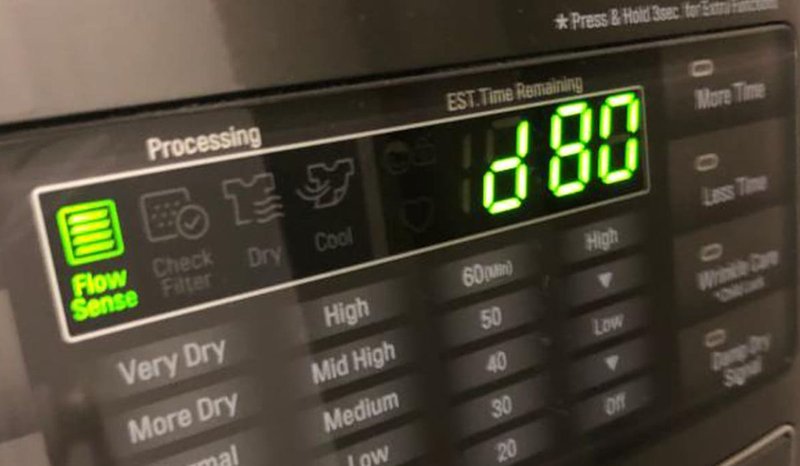
Imagine if you were baking a cake, and your oven’s temperature dial was acting up. The cake might end up overbaked or undercooked because the oven can’t maintain the right temperature. The same goes for your dryer. When the temperature sensor isn’t working properly, your clothes might either stay damp or get overly hot. Now, let’s go over what typically causes this pesky E2 message, and how you can resolve it.
Understanding the E2 Error Code in Simple Terms
So, let’s get into what that E2 error code really means. Essentially, it’s your LG dryer’s way of telling you there’s a *temperature sensing issue*. You see, inside your dryer, there’s a nifty little device called a thermistor. Think of the thermistor as a thermometer that keeps tabs on how hot things are getting in there. If it fails to get a proper read on the temperature, it sends a signal that something’s off, resulting in the E2 error code.
You might be wondering, “Why does this happen?” Well, over time, things like dust, moisture, or just plain wear and tear can affect the thermistor. It’s like if you’ve been reading in low light for too long; eventually, you might misread a word. Similarly, the thermistor might start giving inaccurate readings, confusing the dryer’s system. When this happens, your dryer can’t be sure when to stop or continue with its drying cycle, causing the error to appear.
To tackle this, it’s essential to first ensure that the thermistor is clean and properly connected. Sometimes, the solution is as simple as dusting off the sensor or ensuring that it’s securely plugged in. If you’re not comfortable doing this yourself, you can always call in a professional. But remember, understanding what’s happening is half the battle won.
Potential Causes of the E2 Error Code
Now, let’s roll up our sleeves and explore what might be causing this error to pop up on your trusty dryer. One of the most common culprits is, as mentioned, the thermistor itself. Over time, these components can degrade or become obstructed. Just like how a clogged sink doesn’t drain well, a blocked or faulty sensor won’t read temperatures correctly. This is often the number one reason you might see the E2 error buzzing on your display.
Another possible cause is wiring issues. Imagine if your phone charger cable was frayed or broken; it wouldn’t charge your phone efficiently. Similarly, if the wiring that connects the thermistor to the main control board is worn out or damaged, the dryer won’t receive accurate signals. Wires can become loose or pinched, especially in older machines, leading to intermittent or incorrect data transmission that then triggers the E2 error.
Lastly, environmental factors can’t be overlooked. If your dryer is located in a particularly humid or dusty area, these conditions can negatively impact the thermistor’s performance. Just like how we might struggle to breathe in a dust storm, the sensor can get “choked” by dust and debris, leading to malfunctions. To mitigate these potential causes, keeping your laundry area clean and well-ventilated makes all the difference.
Resolving the E2 Error Code
Feeling a little more confident about tackling this issue? Great! Let’s consider some practical steps to resolve the E2 error code. First, the simplest step is to check the thermistor. Unplug the dryer, locate the thermistor (usually near the blower housing or vent opening), and see if it’s clogged or dirty. Gently clean it with a soft cloth or brush. That might be all it takes to get your dryer back on track.
If the problem persists, inspecting the wiring is a smart next move. Check to ensure that all connections are secure and that there are no visible signs of wear and tear. Look for any frayed wires or loose connections that might be causing a weak link in the communication between components. Correcting any issues here can often be the trick to fixing the problem.
But what if you’ve tried these steps and the E2 error is still haunting your dryer? At this point, it might be time to call in the experts. An appliance technician can perform a deeper diagnostic and address more complex issues that could be plaguing your dryer. Remember, regular maintenance can prevent many of these issues from arising in the first place, helping to keep your appliance running smoothly.
Preventing Future E2 Errors
Prevention is always better than cure, right? Keeping your dryer in tip-top shape doesn’t have to be a pesky chore. A little bit of regular maintenance goes a long way in keeping errors like E2 at bay. Think of it like regular check-ups with your doctor—they help catch little issues before they become significant problems.
To start, ensure that you’re cleaning the lint filter after every cycle. A clogged filter can lead to overheating, which strains the thermistor. Just like wearing sunglasses on a sunny day protects your eyes, a clean filter helps protect your dryer’s components from unnecessary stress. While you’re at it, take the time to check and clean the dryer vent every few months to prevent obstructions that might affect airflow.
Another handy tip? Try to place your dryer in a dry, clean, and well-ventilated area. This minimizes the risk of dust and moisture interfering with the internal components. And, if your dryer’s over a few years old, consider scheduling a professional maintenance check-up annually. It’s like getting your car serviced regularly—it ensures everything runs smoothly and catches any potential problems early on.
And there you have it—your beginner’s guide to understanding and resolving the E2 error on LG dryers. With these steps and tips, you’re well-equipped to handle this error code, keeping your dryer running efficiently and smoothly for many more laundry days to come.